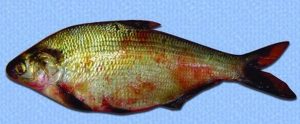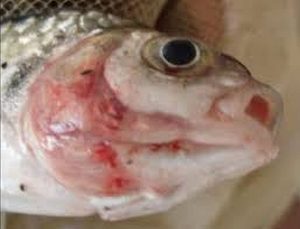Septicemia or Sepsis is a bacterial infection in the bloodstream of the fish that is characterized by sluggishness, lack of appetite, fin damage, reddish discoloration, bulging eyes, and/or clamped fins.
PHYSICAL SYMPTOMS:
Septicemia can be detected initially by redness under the scales of the fish, lesions of hemorrhage, and ulcerations anywhere on the body. Although it can be concentrated in only one area of the body, it will often spread all over the fish’s body.
Although Septicemia is more visible around the face of the fish, it is almost impossible to detect in dark or red colored species.
Open wounds on healthy fish are pinkish in color and normally heal quickly. A gray, black, or fuzzy wound that is discolored around the site of the wound may be infected by Septicemia and should be treated quickly.
Septicemia occasionally shows up as a secondary infection to Popeye (exophthalmia) and can also lead to Dropsy.
Other symptoms like color loss, loss of appetite, general sluggishness, or clamped fins can also be an early indication of Septicemia.
Watch you fish for abnormal behaviors to recognize diseases when they occur.
CAUSE:
Septicemia can be caused by either a bacterial infection (bacterial hemorrhagic septicemia – BHS) or a viral infection (viral hemorrhagic septicemia – VHS).
Nine species of bacteria have been identified as the cause of Hemorrhagic Septicemia including: Aeromonas hydrophilla, Aeromonas sobria, Edwardsiella tarda, Flavobacterium columnare, Plesiomonas shigelloides, Shewanella putrefaciens, Streptococcus agalactiae, Vibrio cholera, and Vibrio fluviaris.
Septicemia occurs when infestations of external parasites cause wounds on the skin of the fish, when open wounds become infected by bacteria and viruses, and when bacteria is consumed by the fish in it’s food.
Common Septicemia will usually occur when an open wound is not kept clean. When humans injure themselves they need to keep the injury clean in order to prevent infection. Fish also need to keep their injuries clean when they become wounded by mishandling, predation, external parasites, fights with other fish, etc. The best way to do this is by performing regular water changes to keep toxins at bay.
Septicemia can also be contracted when fish are fed live and/or frozen foods infected with food born pathogens; usually associated with poor quality tubifex and blackworms
.
TREATMENT:
We usually recommend treating bacterial diseases with antibiotics* sparingly, however, with Septicemia their initial use is strongly recommended.
Septicemia in the blood can quickly overcome an infected fish and an antibiotic treatment regimen is the quickest and most effective way to treat this disease.
Although most aquarium antibiotics are made to dissolve in the tank water where they can be absorbed by the fish, Septicemia is an internal bacterial infection that requires a medicated antibacterial fish food to better target the infection.
Amoxicillin, gentamicin, ofloxacin and sulfamethoxazole/trimethoprim are the drugs of choice for the treatment of Bacterial Hemorrhagic Septicemia.
Aquatronics Osymanna flakes have been around since 1980 and are extremely effective for treating freshwater and marine fish.
Soaking pellets in a concentrated mixture of Mardel’s Maracyn and Maracyn 2 is also an effective method of treating Septicemia. Just chop up the amount you would normally use to treat the tank, add a few drops of water, soak several pellets in the mixture for 10 minutes or so, and feed the affected fish. Add the pre-measured mixture to the tank as per directions.
Because there is no way to accurately measure exactly how much medicated food the fish is eating, especially with the loss of appetite that is commonly associated with the disease, the method is not fool proof. This is why it is so important to administer the medicated food while the fish is still eating.
If the fish is no longer eating, employ the standard method of adding antibiotics to the tank water.
Because most tropical fish keeping enthusiasts have no way of determining the specific type of bacteria that infected the fish, a broad spectrum antibiotic or combination (like those below) that treats both gram positive and gram negative bacteria is highly recommended.
- Mardel’s Maracyn and Maracyn 2 in combination
- Aquarium Pharmaceuticals Triple Sulfa
- Kanamycin Sulfate (for fish that won’t eat)
PREVENTION:
- Perform regular water changes and testing to prevent bacteria buildup that can lead to Septicemia.
- Do Not overcrowd your tank. Fish wastes builds up quickly even with the best of filtration systems.
- Do Not overfeed your fish. Small quantities of quality foods fed two or three times daily is preferable to a single feeding and minimizes waste buildup.
- Only keep compatible species in a community tank environment. Watch new additions for bullying or nipping and separate or remove them when necessary. Watch for changes to eyes, fins, tails, body, appetite, and behavior.
- Quarantine new fish before placing them in a community tank. It is easier to spot and treat fish diseases in a quarantine tank than in a community environment.
* Antibiotic resistance is a major problem facing tropical fish keeping enthusiasts throughout the world.
Currently there are several strains and one particularly virulent strain of Flavobacterium columnare that has made its way into the aquarium hobby that has been known to kill fish in less than a day and may be untreatable.
Antibiotics should only be used when necessary or when all other treatment regimens fail. Following the manufacturer’s instructions will help to avoid antimicrobial resistance and residues in fish, and can minimize the evolvement of newer, stronger strains of bacteria that cannot be handled with antibiotics.




One Response to “Septicemia”
Trackbacks/Pingbacks
[…] Septicemia […]